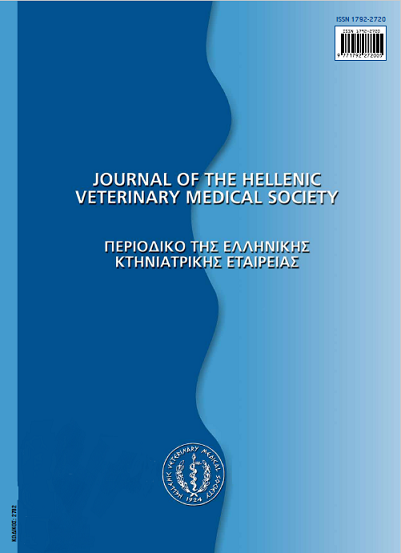Χρήση αναισθητικών ουσιών σε ψάρια ιχθυοκαλλιεργειών

Περίληψη
Η εκτροφή των ψαριών στις ιχθυοκαλλιέργειες απαιτεί μεγάλο αριθμό παρεμβάσεων, οι οποίες, προκειμένου να γίνουν με ευκολία και ασφάλεια, καθιστούν αναγκαία τη χρήση αναισθητικών ουσιών. Η χρήση αναισθητικών ουσιών διευκολύνει τους χειρισμούς και μειώνει το στρες που προκαλείται κατά την εκτέλεση τους, ενώ επιτρέπει την εκτέλεση επώδυνων επεμβάσεων. Ενέργειες, όπως η διαλογή μεγέθους, το τεστ νηκτικής κύστης, ο εμβολιασμός, η σήμανση, η μεταφορά, η αιμοληψία και η τεχνητή γονιμοποίηση, απαιτούν τη χρήση αναισθητικών ουσιών σε δόσεις, οι οποίες, ανάλογα με την περίπτωση, εξασφαλίζουν από ελαφρά ηρέμηση μέχρι βαθιά χειρουργική αναισθησία. Το ιδανικό αναισθητικό για ψάρια ιχθυοκαλλιεργειών πρέπει να εξασφαλίζει γρήγορη εγκατάσταση και ανάνηψη από την αναισθησία, να είναι ασφαλές για τα ψάρια και το χρήστη, να μην αφήνει κατάλοιπα στους ιστούς και να είναι οικονομικό και εύχρηστο. Τα αναισθητικά συνήθως προσλαμβάνονται μέσω των βραγχίων, αφού πρώταδιαλυθούν στο νερό στο οποίο βρίσκονται τα ψάρια. Η ανάνηψη από την αναισθησία γίνεται με τοποθέτηση των ψαριών σε νερό απαλλαγμένο από την αναισθητική ουσία. Η ανταπόκριση των ψαριώνστα αναισθητικά εξαρτάται από το είδος, το μέγεθος και το σωματικό βάρος του ψαριού, την αναλογία μεταξύ του σωματικού βάρουςκαι της επιφάνειας των βραγχίων του, τη λιποπεριεκτικότητα, το φύλο, τη σεξουαλική ωριμότητα, τη φυσική κατάσταση καιτην κατάσταση της υγείας του, αλλά και τη θερμοκρασία, το pH καιτην περιεκτικότητα του νερού στο οποίο διαβιεί σε άλατα, μέταλλακαι οξυγόνο. Τα αναισθητικά που χρησιμοποιούνται σήμερα συχνότερα στα περισσότερα είδη ψαριών είναι η τρικαίνη, η βενξοκαίνη, η φαινοξυαιθανόλη, η κιναλδίνη, η θειική κιναλδίνη, το γαριφαλέλαιο και η μετομιδάτη. Η τρικαίνη είναι η μόνη αναισθητική ουσία που έχει άδεια από τον Οργανισμό Τροφίμων και Φαρμάκων των ΗΠΑ για χρήση σε ψάρια ιχθυοκαλλιεργειών. Είναι εύχρηστη και θεωρείται ασφαλής για τα ψάρια και το χρήστη, έχει όμως υψηλό κόστος αγοράς και απαιτείται χρόνος αναμονής 21 ημερών μετά τη χρήση της. Η βενξοκαίνη είναι ουσία παρόμοια με την τρικαίνη, αλλά πολύ λιγότερο υδατοδιαλυτή, οπότε τα διαλύματα της πρέπει να παρασκευάζονται με αιθανόλη ή ακετόνη. Είναι όμως πιο οικονομική, μετά τη χρήση της απαιτείται χρόνος αναμονής μόνο 24 ωρών και θεωρείται αρκετά ασφαλής για τα ψάρια και τo χρήστη. Η φαινοξυαιθανόλη είναι μετρίως υδατοδιαλυτή, διαλύεται όμως εύκολα σε αιθανόλη. Είναι οικονομική, εύχρηστη, αρκετά ασφαλής για τα ψάρια, αν και ίσως όχι πάντα ασφαλής για το χρήστη, ενώ τα διαλύματα της έχουν, πέραν της αναισθητικής, αντιβακτηριακή και αντιμυκητιακή δράση. Η κιναλδίνη και η θειικήκιναλδίνη είναι εύχρηστες, αλλά η δεύτερη, η οποία είναι και η περισσότερο ασφαλής, είναι ιδιαίτερα ακριβή. Έχει αναφερθεί ότι μπορεί να προκαλέσουν ερεθισμό των βραγχίων και βλάβες του κερατοειδούς χιτώνα των ψαριών, καθώς και ερεθισμό του επιπεφυκότα και αναπνευστικά προβλήματα στο χρήστη. Το γαριφαλέλαιο είναι ελαιώδες υγρό το οποίο περιέχει τις δραστικές ουσίες ευγενόλη και ισοευγενόλη. Είναι οικονομικό και εύχρηστο, έχει αντιμυκητιακή και αντιβακτηριακή δράση, θεωρείται αρκετά ασφαλές για τα ψάρια και το χρήστη και δεν απαιτείται χρόνος αναμονής μετά τη χρήση του. Η μετομιδάτη εξασφαλίζει ταχεία εγκατάσταση, ενώ η ανάνηψη από την αναισθησία μπορεί να είναι παρατεταμένη όταν ο χρόνος έκθεσης είναι μεγάλος. Επιπλέον, φαίνεται να πλεονεκτεί έναντι των άλλων αναισθητικών ουσιών, λόγω του ότι πιθανώς προκαλεί το λιγότερο στρες στα ψάρια κατά τη διαδικασία αναισθητοποίησής τους.
Λεπτομέρειες άρθρου
- Πώς να δημιουργήσετε Αναφορές
-
TSANTILAS (Η. ΤΣΑΝΤΗΛΑΣ) H., GALATOS (Α. Δ. ΓΑΛΑΤΟΣ) A. D., & ATHANASSOPOULOU (ΑΘΑΝΑΣΟΠΟΥΛΟΥ Φ.) F. (2017). Χρήση αναισθητικών ουσιών σε ψάρια ιχθυοκαλλιεργειών. Περιοδικό της Ελληνικής Κτηνιατρικής Εταιρείας, 56(2), 130–137. https://doi.org/10.12681/jhvms.15077
- Τεύχος
- Τόμ. 56 Αρ. 2 (2005)
- Ενότητα
- Review Articles
Οι συγγραφείς των άρθρων που δημοσιεύονται στο περιοδικό διατηρούν τα δικαιώματα πνευματικής ιδιοκτησίας επί των άρθρων τους, δίνοντας στο περιοδικό το δικαίωμα της πρώτης δημοσίευσης.
Άρθρα που δημοσιεύονται στο περιοδικό διατίθενται με άδεια Creative Commons 4.0 Non Commercial και σύμφωνα με την άδεια μπορούν να χρησιμοποιούνται ελεύθερα, με αναφορά στο/στη συγγραφέα και στην πρώτη δημοσίευση για μη κερδοσκοπικούς σκοπούς.
Οι συγγραφείς μπορούν να καταθέσουν το άρθρο σε ιδρυματικό ή άλλο αποθετήριο ή/και να το δημοσιεύσουν σε άλλη έκδοση, με υποχρεωτική την αναφορά πρώτης δημοσίευσης στο J Hellenic Vet Med Soc
Οι συγγραφείς ενθαρρύνονται να καταθέσουν σε αποθετήριο ή να δημοσιεύσουν την εργασία τους στο διαδίκτυο πριν ή κατά τη διαδικασία υποβολής και αξιολόγησής της.






